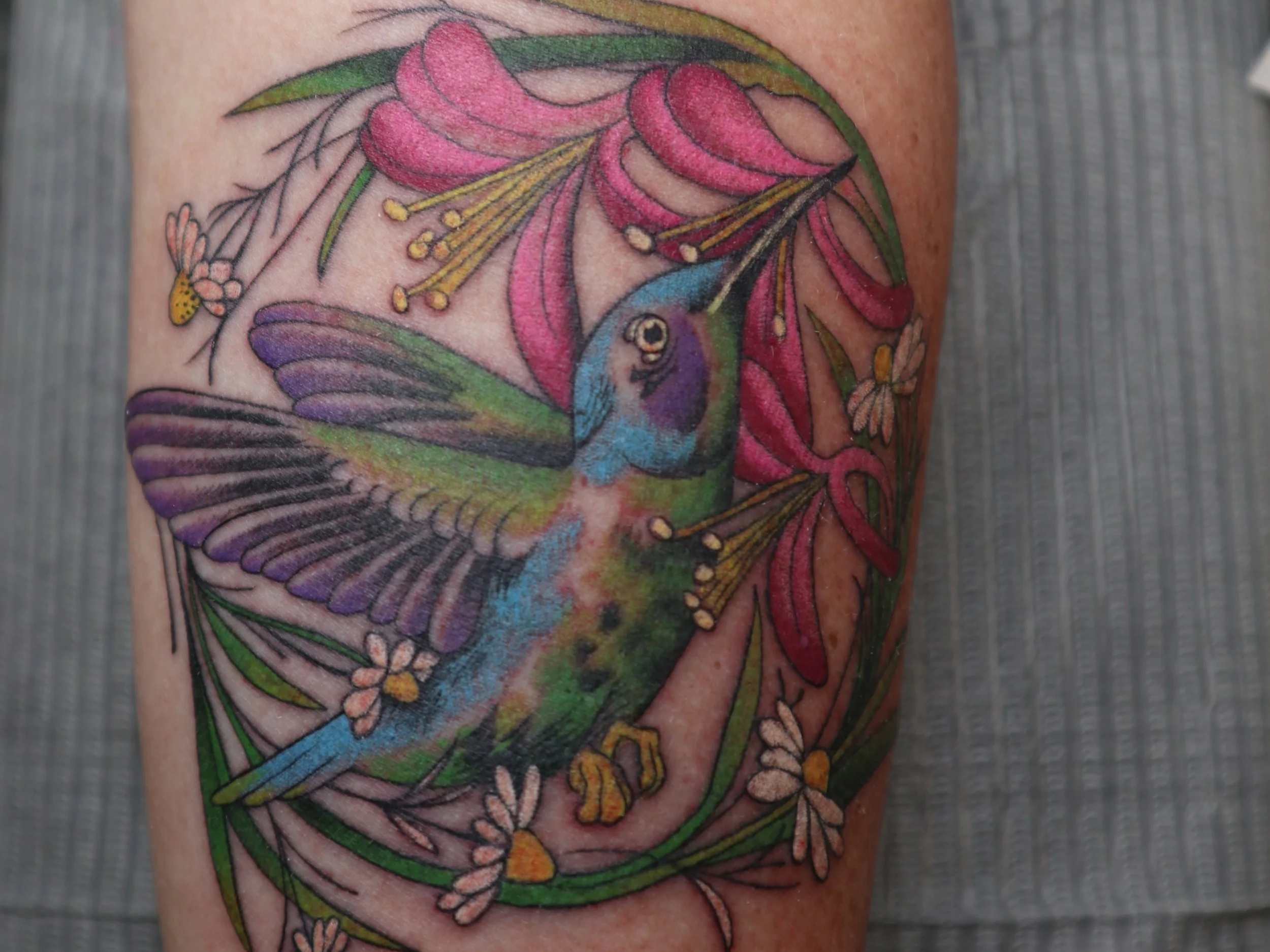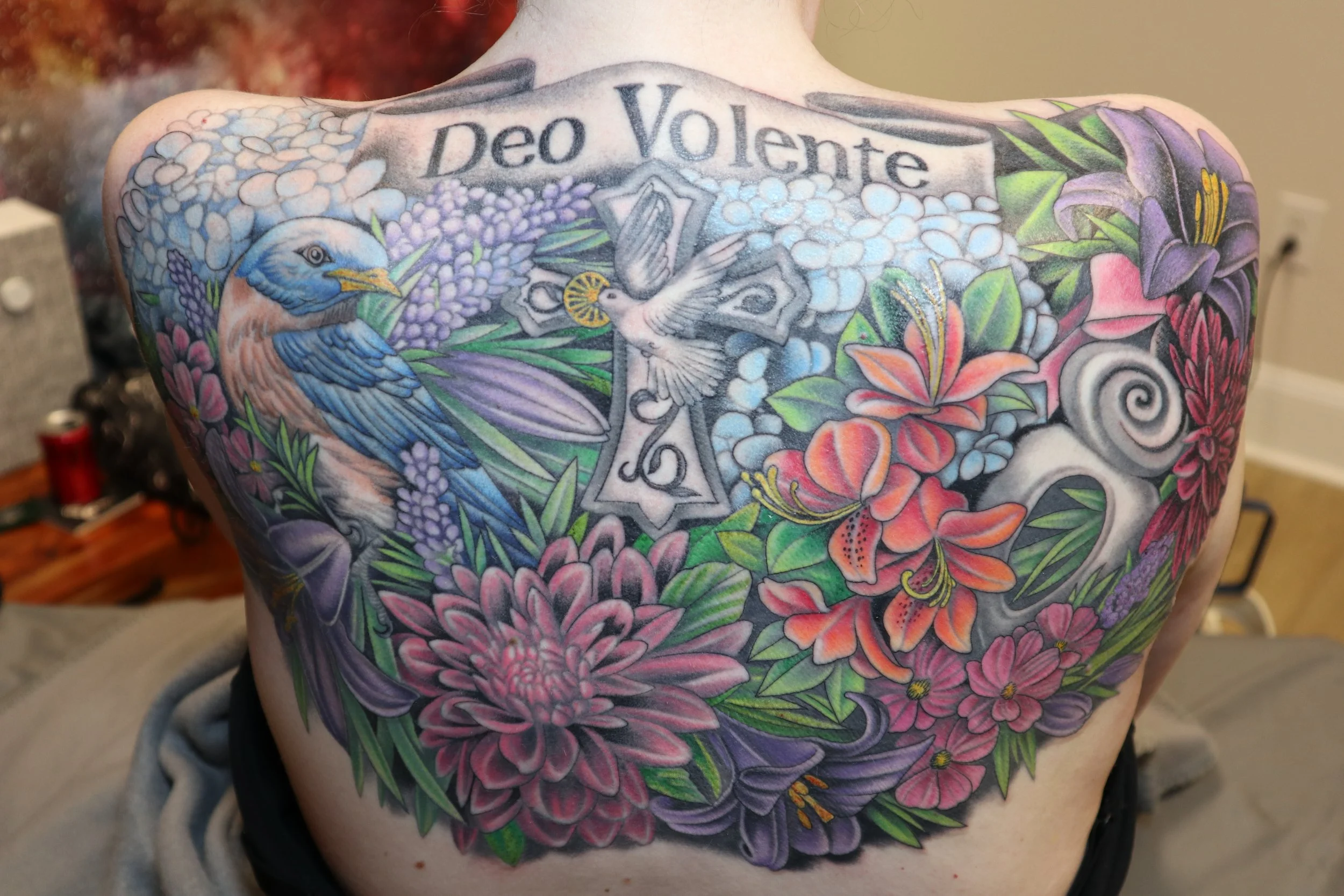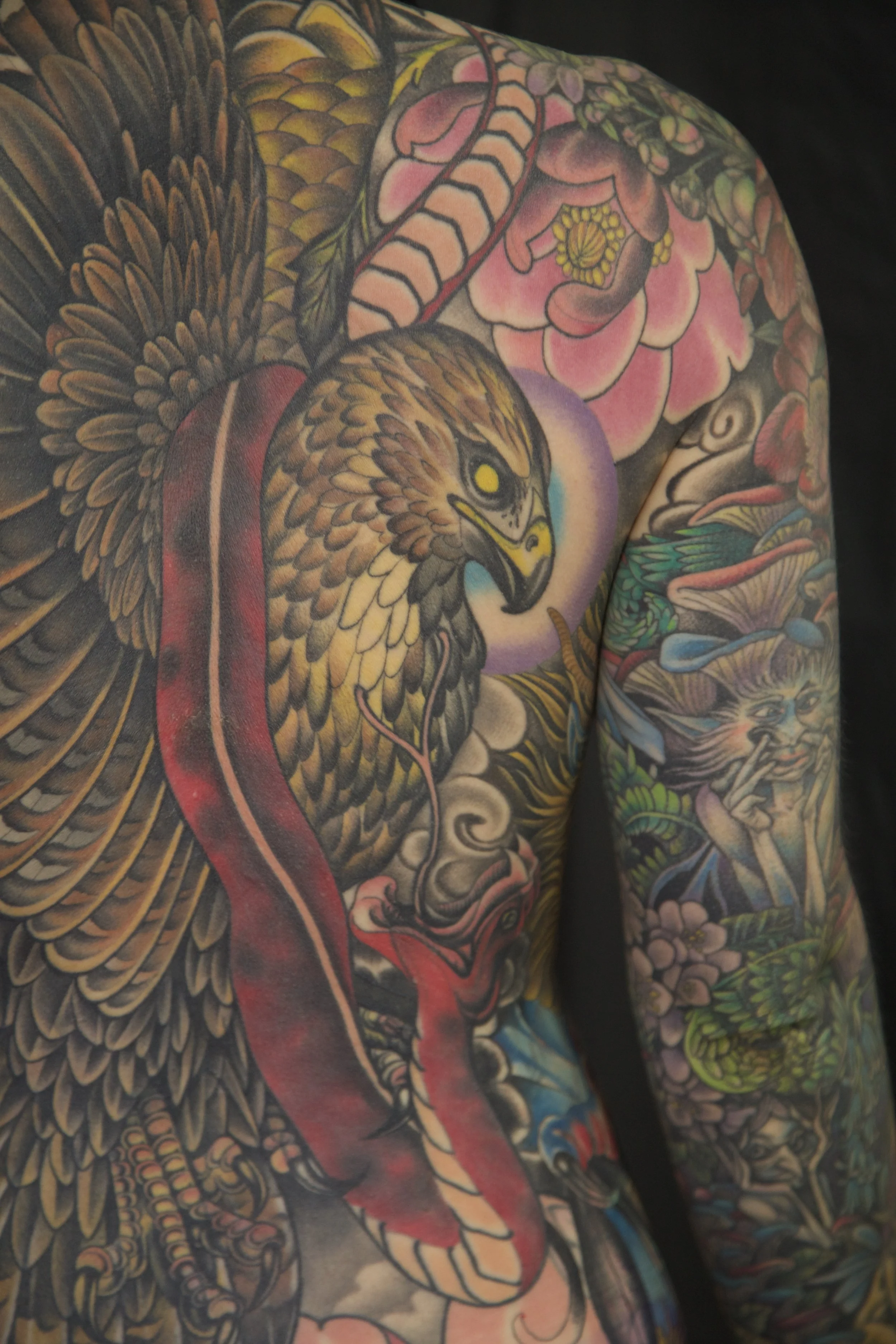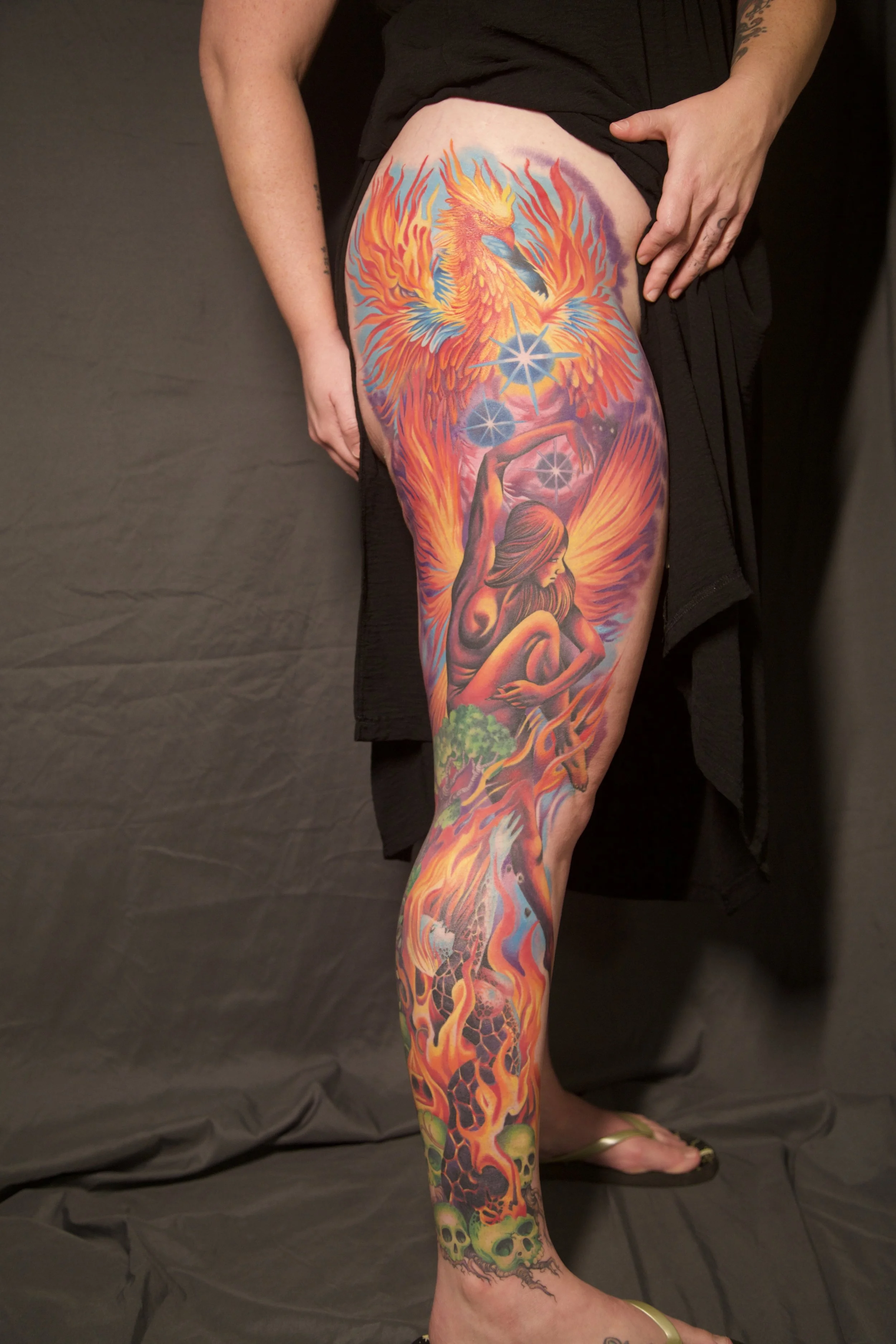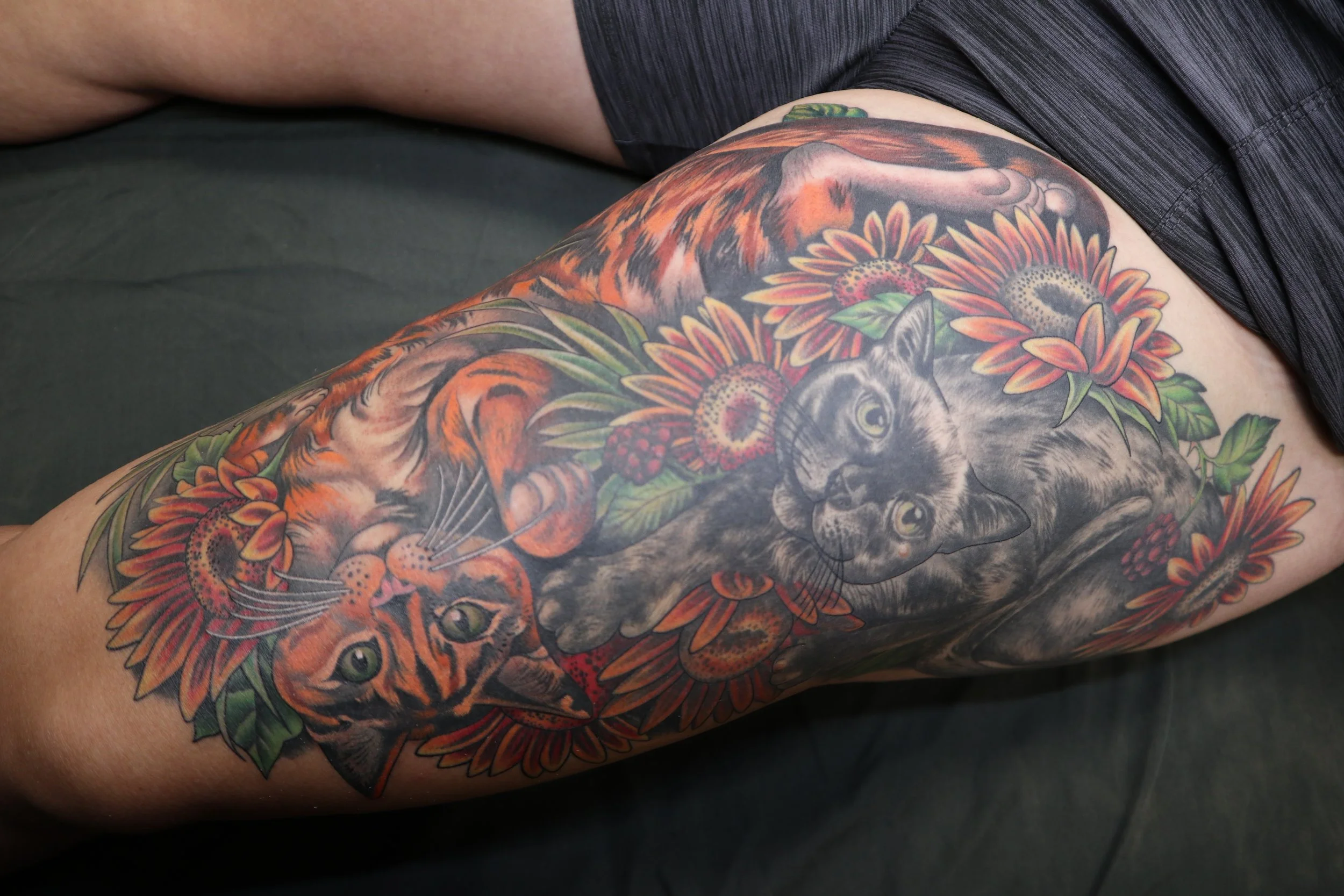The Therapeutic Power of Tattoos: Healing Through Ink
For many, tattooing is far more than body art; it is an experience with therapeutic value. Whether it marks survival, loss, transformation, or identity, the act of depositing ink beneath the skin has always carried meaning and meaning making which, as psychology and neuroscience teaches us, is central to healing. Tattooing invites us to translate our inner experience into something visible and lasting. It is an act that fuses story, belief, emotion, and definition. In this sense, the tattoo becomes not only art, but a process of personal integration.
Foreword from Selina: I’ve always believed that tattooing is a healing art—but through Joseph’s deep, introspective writing and our conversations, we’ve finally been able to articulate and piece together the foundations that explain how and why it truly is.
Article by Joseph Mounts MAR, M.Ed., AADC, LPC
Co-Authored by Selina Medina
Hummingbird tattoo for a client who was experience a life change.
From Belief to Story: How Tattoos Reflect Inner Change
When people tell the story of why they got a particular tattoo, it’s rarely about decoration. It’s about narrative — about anchoring something within themselves that feels too important to be forgotten or a process undergone that holds too much meaning to not be memorialized.
Modern research supports this lived wisdom. Studies suggest tattoos can help individuals process trauma, reclaim their bodies after harm, and reduce anxiety or dissatisfaction by reasserting agency and control.¹ For trauma survivors, especially, tattoos often serve as a visible act of self definition — a way to reclaim ownership of a body once associated with pain.²
From a psychological perspective, this process touches both cognition and narrative. Cognitive behavioral models remind us that belief shapes emotion, and action reinforces belief. When a person chooses to inscribe meaning on their body, they are literally acting upon their story -replacing old beliefs of helplessness or unworthiness with visible proof of agency.
Narrative therapies expand this further. Trauma and loss often compress life into a single story: I am broken. I am what happened to me. Tattooing can gently disrupt that narrative, offering space for new chapters to emerge. Each design becomes a sentence in a rewritten story — one centered not on suffering, but on growth and meaning.
Through this act, the individual moves from being the one life happens to, toward becoming the author and protagonist of their own story. A tattoo, then, is both an assertion and an invitation that reminds the individual that their identity is not fixed or frozen. They can be rebuilt into something beautiful and new.
Feeling and Enduring: The Emotional Dimension of Healing
While tattoos give form to belief and story, they also engage something deeper — the realm of emotion and sensation. Healing requires the capacity to feel, to endure, and to integrate what arises.
Dialectical Behavior Therapy (DBT) specifically teaches that transformation often begins with radical acceptance — facing pain instead of resisting it. Tattooing mirrors this process. The individual willingly meets discomfort and, through endurance, transforms it into something chosen and meaningful. This is not specifically a reference to the pain of the tattoo needle, but the facing of often intense and uncomfortable emotions surrounding the intention and commitment to undergo the transformative process.
Emotional exposure involves the vulnerability of being seen, of surrendering to the process, and of making a lasting mark that represents something deeply personal. It asks the individual to stay present with what arises: fear, uncertainty, grief, even hope. This mirrors therapeutic work, where progress depends not on avoiding emotion, but on allowing it to be felt, tolerated, and understood. Each moment of endurance strengthens emotional regulation — a learned confidence that one can face pain, both physical and psychological, and remain intact.
From a therapeutic perspective, this process engages both emotional regulation and exposure principles. By choosing to approach rather than avoid discomfort, the individual rewires the learned associations between distress and danger. The experience becomes corrective: the body and mind discover that pain can coexist with safety. This interplay between awareness, choice, and tolerance is what makes tattooing, for some, a profound act of healing.
In recent years, neuroscience has begun to map how these emotional and somatic processes work together. What psychology once described as “facing one’s pain” can now be seen in neural terms — as the brain’s capacity to reorganize itself through safe, intentional engagement with content of difficult experiences.
“If God Wills it.” The art of change of letting go. A tattoo done to hallmark the triumph of a client over cancer.
Neuroscience of Embodied Healing
Modern trauma theory echoes this idea. As Bessel van der Kolk writes in The Body Keeps the Score (2014), the body remembers both the pain of what was endured and the possibility of renewal. Just as trauma can be stored in muscle and breath, healing can also be embodied. Intentional, positive physical experiences that are grounded in choice, safety, and meaning can help rewrite those physiological imprints.
Research in affective neuroscience and trauma therapy supports the idea that intentional, body-based experiences can help reorganize emotional and physiological memory. When a person voluntarily engages in a controlled experience of discomfort within a safe context — such as tattooing, yoga, or other forms of somatic practice — the brain’s limbic and sensory systems become active. This allows new associations of safety, choice, and mastery to form.
Studies by Bessel van der Kolk (2014) and Peter Levine (2010) suggest that trauma is often stored as implicit, nonverbal memory in the body and subcortical brain regions such as the amygdala and brainstem. Re-engaging these systems through safe physical experiences can help “complete” defensive responses that were once frozen in fear. Stephen Porges’ (2011) Polyvagal Theory adds that sensations of safety and connection activate the ventral vagal system, shifting the body out of threat and into regulation.
Daniel Siegel (2012) notes in his work on interpersonal neurobiology that change occurs when new neural pathways integrate emotion, body, and meaning — a process often achieved through embodied awareness and mindful engagement. In this sense, tattooing can provide a concrete, sensory experience of reclaiming the body and reshaping how pain, safety, and identity are encoded in the nervous system. It must be noted, however, that a trauma-informed artist is necessary to ensure that the requisites of experience are met — the artist must be able to create a collaborative environment that facilitates a controlled experience within a safe context.
The reflection of inner self, a tattoo commemorating growth and passing of time and age.
The Space and the Artist: Facilitating Safety and Integration
Just as therapy depends on trust, containment, and attunement, so too does the tattoo process when it takes on therapeutic meaning and value. The neurobiological processes described above — engaging the sensory, emotional, and regulatory systems — can only occur within an environment that feels safe and collaborative. Safety, both psychological and physiological, allows the body to interpret pain as tolerable rather than threatening, and this is where the role of the artist becomes essential.
A skilled tattoo artist does more than render an image; they co-create an experience. The artist’s ability to provide structure, predictability, and emotional attunement parallels the therapist’s role in trauma-informed care. When an artist communicates clearly, obtains consent throughout the process, and responds sensitively to a client’s needs, they help regulate the client’s nervous system in real time. This co-regulation can transform what might otherwise be a distressing experience into one that fosters mastery and integration.
From a psychological perspective, this collaborative process reinforces the core mechanisms of healing: agency, trust, and meaning-making. The individual’s participation in designing and choosing the tattoo mirrors CBT’s emphasis on intentional action and DBT’s principle of tolerating discomfort through mindful presence. Narrative Therapy also finds its expression here — the artist and client together give external form to an evolving story, translating internal change into visual language and artistry.
The studio environment itself can further support this process. A calm, private, and respectful setting reduces external stressors and promotes physiological safety. The rhythmic hum of the tattoo machine and the predictable structure of the session provide sensory cues that can anchor the client’s attention and body awareness, similar to grounding techniques used in therapy. In such a space, tattooing becomes a structured and embodied intervention — an act of expression that engages both mind and body in the service of healing.
Rising from the ashes, a tattoo that hallmarked a clients significant life change through divorce and regaining herself.
A trauma-informed artist, therefore, serves as a facilitator of emotional safety and embodiment. By maintaining awareness of pacing, consent, and the client’s comfort, they create conditions for a reparative experience.
When these psychological and physiological conditions of safety are met, the tattoo becomes a catalyst of change moving beyond the tattoo sessions themselves. The tattoo lives on within the body as a new pattern of memory, resilience, and self-definition paralleling many traditional practices of tattooing. What modern science now articulates in neurological terms, ancient traditions understood intuitively: that the body and mind are inseparable in the process of becoming whole. Tattooing reclaims something our modern world often forgets — that the body is not an obstacle to healing, but an active participant in it.
Commemoration of a pet’s passing, and symbolizing the youth of another.
Cautionary Notes and Limitations
Of course, tattoos are not professional therapy in themselves, nor should it be used as a replacement for professional counseling; but tattoos, as a part of an overall therapeutic process, can have value and contribute to healing assuming that the noted prerequisites and conditions are facilitated by the artist. Without these tattoos are often impulsive, thoughtless, or later regretted.A lot of work needs to be done before the needle touches the skin.
It is best to avoid artists that don’t offer consultations, take the time to listen, or make the effort to create a comfortable welcoming environment so that safety can be established. Currently there is no way to know if an artist is aware of the healing nature and process of tattoos. There are no current certifications or markers; however, these are signs to discern whether an artist is invested in you as a client.
The bottom line is that tattoos within a broader therapy context show promise of promoting healing and personal integration; however, more research is necessary in this area of study.
Conclusion
Tattoos are living symbols of transformation — visible reminders that healing is not an erasure of what was, but an integration of what is. They represent the courage to face pain, to find meaning in it, and to carry that meaning forward.
Throughout this exploration, we’ve seen how the act of tattooing touches the same principles that underlie psychological healing. It begins with intention and awareness, asking us to confront what has been hidden or painful. Through the endurance of the process, both emotional and physical, we learn that discomfort can coexist with safety, choice, and even beauty. Neuroscience affirms what human beings have long known intuitively: when body, emotion, and meaning align, transformation becomes possible.
Tattooing, then, parallels therapeutic healing in its movement from insight to embodiment. It bridges cognition and sensation, story and skin — uniting the mind’s understanding with the body’s.
Breathing new life into an older tattoo where the client resonates with the story of a goddess Lilith. The depiction spans the entire leg and is more intricate beyond this level of completion.
References
Atkinson, M. (2004). Tattooing and civilizing processes: Body modification as self-control. Canadian Review of Sociology and Anthropology, 41(2), 125–146.
Curtis, C. (2024). Ink-ling of identity: Unraveling tattoo culture for mental health counselors. The Professional Counselor, 14(3), 241–254.
Dickson, L., Dukes, R. L., Smith, H., & Strapko, N. (2015). To ink or not to ink: The meaning of tattoos among college students. College Student Journal, 49(2), 181–192.
Levine, P. A. (1997). Waking the tiger: Healing trauma. North Atlantic Books.
Levine, P. A. (2010). In an unspoken voice: How the body releases trauma and restores goodness. North Atlantic Books.
Ogden, P., Minton, K., & Pain, C. (2006). Trauma and the body: A sensorimotor approach to psychotherapy. W. W. Norton.
Porges, S. W. (2011). The polyvagal theory: Neurophysiological foundations of emotions, attachment, communication, and self-regulation. W. W. Norton.
Siegel, D. J. (2012). The developing mind: How relationships and the brain interact to shape who we are (2nd ed.). Guilford Press.
Tiggemann, M., & Hopkins, L. A. (2011). Tattoos and piercings: Bodily expressions of uniqueness and conformity. Body Image, 8(3), 237–244.
Van der Kolk, B. A. (2014). The body keeps the score: Brain, mind, and body in the healing of trauma. Viking.
Wohlrab, S., Stahl, J., &; Kappeler, P. M. (2007). Modifying the body: Motivations for getting tattooed and pierced. Body Image, 4(1), 87–95.


